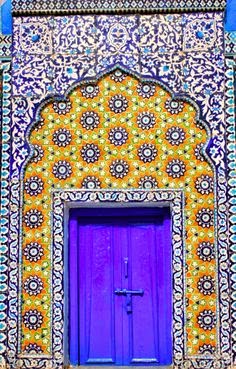Stamps Showing Llyod Barrage issued on 14 August 1948
Inauguration of Lloyd Barrage at Sukkur (The Daily Gazette, Edition of 14 January 1932). This rare edition of The Daily Gazette (later became The Sind Gazette) shows the Viceroy of India, Lord Willingdon, who inaugurated the Lloyd Barrage (built over Indus River near Sukkur) on 13 January 1932. It was later named as the Sukkur Barrage. The scheme had been launched by the Governor of Bombay, Sir George Ambrose Lloyd for whom it was named.
Plaque at The Lloyd Barrage Sukkur, also known as Sukkur Barrage. Photo by Danyal Gilani
Lloyd Barrage Museum, Sukkur
Entrance to Dadu Canal, Sukkur Barrage. Dadu Canal is one of the three canals emanting from Sukkur Barrage on the western bank of Indus River.
Three Canals Emanating from Sukkur Barrage at the Right Bank of Indus River. These three canals are Dadu Canal, Rice Canal and Kirthar Canal. Photo by Jahangir Khan.
War Mubarak Shrine in Rohri City. The Shrine of War Mubarak is located near Rohri Railway station towards Sukkur. This Shrine holds a holy Hair of Prophet Mohammed (PBUH). A building was erected around 1545 AD (952 AH) by Mir Muhammad, the then reigning Kalhora Prince, for the special reception of a holy Hair
Minar-e-Masumi and Faiz Mahal at Sukkur. The minaret of Syed Nizam-ud-Din Mir Muhammad Masum Shah (a governor of Mughal Emperor Akbar) is the most conspicuous structure of Sukkur town which can be seen from a far distance. It is called ‘Mir Masum Shah Jo Minaro’ in Sindhi language.This conical shaped minaret was built around 1607 AD (26 metres in circumference, 31 metres in height with 84 steps to the top)
Sateen Jo Aastan, “The Tombs of Seven Sisters” at Rohri. Sateen Jo Aastan is located on the left bank of the Indus River near Rohri on a small hill. A building on the southern side of the hill is called Satbhain (Seven Sisters). According to folklore seven unmarried female friends resided here who veiled themselves from all males. But for the fear of a tyrannical Raja, they disappeared in a cave in the side of a hill. Thus they became satti. Probably this folklore has its origins in the Hindu ritual of satti, where widows burnt themselves on their dead husband’s pyre. In reality, however, this is the burial-place of a ruler from Sukkur, Mir Abu Al-Qasim Namkeen (961 A.H, 993 A.H).
On one of the smaller hills that arises out of the river bank on the south has a leveled platform on which there are many carved gravestones. The principal grave is that of Mir Kasim one of the Sabzwari Shahids dated 1018 AD. This was probably the grave that sanctified the place, and the lamp-post and lamp that were placed in front of it are still there; and it gives the name of Than Kasim Shah to the hill. But the name by which it is more generally known is the Hill of the Seven Virgins.
On one of the smaller hills that arises out of the river bank on the south has a leveled platform on which there are many carved gravestones. The principal grave is that of Mir Kasim one of the Sabzwari Shahids dated 1018 AD. This was probably the grave that sanctified the place, and the lamp-post and lamp that were placed in front of it are still there; and it gives the name of Than Kasim Shah to the hill. But the name by which it is more generally known is the Hill of the Seven Virgins.
Another View of Seven Sisters Graveyard at Rohri. Ayub Bridge and Lansdowne Bridge are visible in the background.
Jamia Masjid, Sukkur.
Clock Tower at Ghanta Ghar Chowk, Sukkur.
Pir Ilahi Baksh Tower (Ilmi Tower), Sukkur. Pir Illahi Bakhsh Tower (also called ‘Ilmi Tower’) is located on a hill near State Bank of Pakistan, Sukkur. It is 110 feet high and 66 feet wide. The tower was founded by Pir Illahi Bakhsh, minister for education in May 1939 and completed in 1940
Sukkur Railway Station.
Railway Heritage Museum at Sukkur. Railway Heritage Museum was established in 2005 at Sukkur Railway Station. An old steam engine and a few coaches were brought from Mirpur Khas section. Antiques were collected from almost 60 stations of Sukkur and displayed inside the coaches
Sukkur Airport Terminal Building
A Globe near Lab-e-Mehran Park, Sukkur
Hockey Stadium, Sukkur. Built at old Railway Ground.
Night View of Icon Departmental Store near Minar-e-Masumi, Sukkur
Civil Hospital, Sukkur
IBA (Institute of Business Administration), Sukkur
St. Mary’s High School, Sukkur. St. Mary’s School was started in 1881. But it was not recognized till 1888. It was initially for the children of railway personnel, but in 1897 it was opened to all local people. It was housed in a railway bungalow and shifted to its own building on 23 May 1911. Photo shows St. Mary’s School and church. Photo by SAN Group 2k.
School website: http://www.geocities.ws/uzairarain/School.htm.
School website: http://www.geocities.ws/uzairarain/School.htm.
Saint Mary’s Catholic Church at Sukkur. St. Mary’s Church was built in early 1850s. In February 2006, a mob destroyed the church and was rebuilt and opened in 2009. This photo was taken in 1992. Photo by Francis Hannaway.
Sadh Belo, A Sacred Place for Hindu in an Island at Sukkur. Downstream of the island of Bukkur, and separated from it by a short stretch of river, is the small island of Sat, or Sadh, Belo. On it is a Hindu religious establishment found in AD 1823 by Swami Bakhandi Maharaj Udasi. It is a sacred pilgrimage place for Hindus throughout Sindh and even in India. The island has two inlets, Sadh Belo and Din Belo. To visit Sadh Belo one requires a permission from the department of Auqaf to go there.







































%2BKhairpur%2C%2BSindh.jpg)








.jpg)

.jpg)
.jpg)
.jpg)
.jpg)
.jpg)
.jpg)
.jpg)

